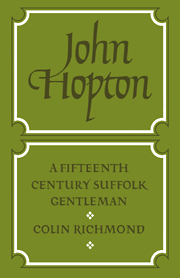2 - The estates
Published online by Cambridge University Press: 30 October 2009
Summary
‘Read all thy ancestors' books of accounts. It may be thou mayest find somewhat out of them that will be worth thy labour.’
Sir John Oglander A Royalist's Notebook, p229‘my maister…gaf me these wetche woordys: that there was no man of wurship in Norfolk that hath so many auditours of fee as he hadde, and yet cowde he never knowe the certeynté how hise lyvelode was disposed’
Geoffrey Sperlyng writing to John Paston I about Sir John Fastolf, 6 January 1460 Davis 11, p202We lack information for Swillington and the other Yorkshire estates. Just how unfortunate is this gap in our knowledge is demonstrated by the two accounts which survive for Swillington. Even those chance and random survivors do not date from John Hopton's lifetime. Moreover they are not only over a hundred years apart, they are entirely dissimilar. Nonetheless one of them at least is most revealing.
The first account is of Thomas Clerk, described as receiver of monies from the sale of grain and stock. It is for 1408–9. All we need notice from it here is that such sales fetched over £70, while the costs of production were £11, and other payments £12. Liveries of cash to Sir Roger Swillington at Westwood, the manor house which stood on the boundary between Blythburgh and Walberswick, were over £60.
The second account is of William Dinley, bailiff, for 1522–3.
- Type
- Chapter
- Information
- John Hopton: A Fifteenth Century Suffolk Gentleman , pp. 31 - 101Publisher: Cambridge University PressPrint publication year: 1981



